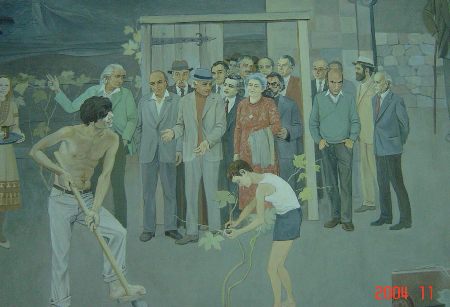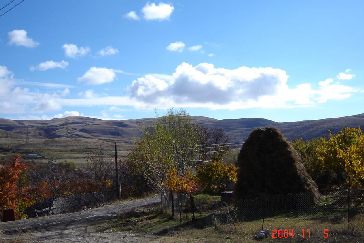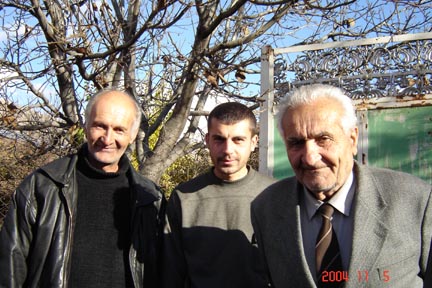
the Soil Before Colleagues
(� R. Bedevian/Groong)
Armenian News Network / Groong
December 7, 2004
Travel Wire
By Ruth Bedevian
ZANGAKATUN, ARMENIA
Zangakatun is in the Ararat Province which one reaches by driving south easterly from Yerevan for about 40-45 minutes. Nestled in this rich agricultural part of the country is this bucolic village which is dry and hilly and where tamarisk, buckthorn and spurge grow naturally. It is here where the larks, wrens and finches nest and where the home, museum and final resting place of Baruyr Sevag (1924-1971) is found, one of Armenia's most beloved poets. Following WW II, Baruyr Sevag emerged most popular among Armenians worldwide. He was particularly idolized by the youth. Charentz was to the first half of the century what Baruyr Sevag was to the second half. He was steadfast in nurturing the changing hearts and minds of a Soviet Armenian culture, giving light to ideas, values and social norms that were yet to be touched, seen, and felt in future generations.
Avedik Grigoryan, the director since 1992, greeted my friend and me warmly, especially upon learning that this visit was my third attempt to gain entry beyond the gate that surrounds the grounds. He as well as his father Varazdat, were Sevag's neighbors and friends. `I knew him all my life,' the elder Grigoryan related emotionally. When asked to share his fondest memory, he thought for a moment and then recalled, `He loved his people. He was a very patriotic and hospitable man and loved to gather his friends to his table. He loved having guests and not one or two at a time, but throngs of friends - eating, singing and enjoying exchanges of stories and ideas.' Now retired from his position as the director of the local school, Varazdat Grigoryan, continued to recollect, `Sevag loved it here. He contemplated and worked best in these peaceful surroundings.'
Walking through the vineyards whose vines still bore grapes in the early November sun and leading us through the apple and pear orchards which Sevag himself planted, Avedik Grigoryan began telling us that Sevag's home is still owned by the poet's family and is not open to the public. The Director detailed some facts, relating that Sevag was born to a farming family in the village of Zangakatun. (until 1948 Chanakhchi, then till recently Sovetashen) in the town of Vedi. Married at 24 for a brief time to Maya Avakian, who left him, Sevag had one son, Hratchia, from that first marriage. From his second marriage to Nelly, a woman of Georgian and Russian origin, he had two sons. Gouriun lives in Glendale, California and Armen lives in Yerevan and also uses this home.
Early on Sevag developed a passion for reading. Studying humanities at Yerevan State University, he discovered the banned books and poems written by Charentz and enrapt himself, specializing in Armenian literature and grammar. He ultimately earned his doctorate degree in ancient Armenian literature.

|
|
Artist Portrayal of Sevag Tilling the Soil Before Colleagues (� R. Bedevian/Groong) |
Grigoryan continued to brief us on the poet's contributions. He was given his pen name in the 40s by the editor of the Soviet Armenian Literature newspaper, R. Zoryan. During the years 1941-1942, at the age of 18, Sevag wrote several volumes of poetry called Requiem, Sonnetner (Sonnets), Agothkner (Prayers) and a very long poem called Lucine (Moon). In 1942 his poems Ankhoragir (Without Title), Pntrumner (Searches) and Zghjum (Regret) were written. Paterazmi Dashtin Zohvatsnerin (To The Martyrs of the Battlefield) was approved by its editor, R. Zoryan and published in the Soviet Armenian Literature Newspaper. Because of the `nationalistic' nature of that work, he was badly criticized and his writing banned. Also, R. Zoryan was fired. It wasn't until 1948 that Sevag was published again. Between 1949 and 1951 he became the chief editor of the Armenian literary journal called Grakan Tert (Literary Newspaper). He began to lecture at colleges and universities throughout Armenia and continued to write with honesty, integrity and humanity. His popularity threatened his colleagues at the Writers' Union and he was obliged to leave Yerevan for Moscow where he advanced his studies, graduating with highest honors (1956) from M. Gorky's Institute of Literature and Poetry. Bitter upon being so maligned and forced to leave his beloved homeland, he said, `I am glad that Soviet Union is not limited to Armenian Writers' Union and Armenian Republic.'

|
|
View from Sevag Home (� R. Bedevian/Groong) |
Leaving the museum, we strolled through the orchards, the foliage still full and fruit-laden, to the gravesite where Sevag and his wife are buried. Flowers strewn the rock-hewn monument that covers his grave and there were candles that had been lit in the crevices of the stone, evidence of the adoration in which he is held by the nation of people he loved.

|
|
Three Generations of Grigoryans: Avedik, Aram, Varazdat (� ANN/Groong) |
Plan a visit by first telephoning to make sure you are expected. When the operator answers, say Vedi/ Zangakatun - Telephone Code 1-07 - 132. This is a direct line to the Grigoryan household.
Baruyr Sevag Museum Zangakatun, Ararat Marz (Province) Grigoryan, Avedik Tel: (374-34) 132
|
Redistribution of Groong articles, such as this one, to any other
media, including but not limited to other mailing lists and Usenet
bulletin boards, is strictly prohibited without prior written
consent from Groong's Administrator. � Copyright 2004 Armenian News Network/Groong. All Rights Reserved. |
|---|